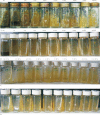Evaluation of berries of Phytolacca dodecandra for growth inhibition of Histoplasma capsulatum var. farciminosum and treatment of cases of epizootic lymphangitis in Ethiopia
- PMID: 23569960
- PMCID: PMC3609337
- DOI: 10.1016/S2221-1691(12)60086-0
Evaluation of berries of Phytolacca dodecandra for growth inhibition of Histoplasma capsulatum var. farciminosum and treatment of cases of epizootic lymphangitis in Ethiopia
Abstract
Objective: To evaluate the berries of Phytolacca dodecandra (P. dodecandra) for its effect on Histoplasma capsulatum var. farciminosum (HCF) and for the treatment of cases of epizootic lymphangitis (EL).
Methods: Samples were collected from un-ruptured nodules of cases of EL at Debre Zeit and Akaki (central Ethiopia). Mycological culture and isolation of HCF were performed at the Aklilu Lemma Institute of Pathobiology. Phytochemical screening was done for n-butanol extract of P. dodecandra to detect alkaloids, saponins, phenolic compounds and flavonoids. The minimum inhibitory concentrations (MICs) and minimum fungicidal concentrations (MFCs) of aqueous and n-butanol extracts of P. dodecandra against HCF were determined by agar dilution assay. For the in vivo trial, 5% simple ointment was prepared from n-butanol extract and applied topically to 24 (twelve early and twelve moderate) cases of EL.
Results: Phytochemical screening showed that n-butanol extract of P. dodecandra was positive for alkaloids, saponins and phenolic compounds but negative for flavonoids. The MICs of n-butanol and aqueous extracts of P. dodecandra were (0.039%-0.078%) and (0.625%-1.250%), respectively. The MFCs of n-butanol and aqueous extracts of P. dodecandra were (0.078%-0.156%) and (1.250%-2.500%), respectively. The MIC and MFC of ketoconazole (positive control) was (1.200×10(-5)%-2.500×10(-5)%) and (5.000×10(-5)%-1.000×10(-4)%), respectively while growth was observed on free medium (negative control). From the total of 24 treated cases of EL, 14 (58.3%) responded to treatment; however, 10 (41.7%) did not respond to treatment. There was no significant difference in the degree of response to treatment between early and moderate cases (χ(2)=0.686; P=0.408).
Conclusions: It can be concluded that n-butanol extract of P. dodecandra demonstrates antifungal effects while the aqueous extract shows no antifungal activity.
Keywords: Agar dilution assay; Antifungal activity; Chronic disease; Contagious disease; Epizootic lymphangitis; Histoplasma capsulatum var. farciminosum; In vivo trial; Lymphangitis; Minimum fungicidal; Minimum inhibitory concentration; Mycological culture; Phytochemical screening; Phytolacca dodecandra; concentration.
Conflict of interest statement
Figures



Similar articles
-
Growth inhibitory effect of selected medicinal plants from Southern Ethiopia on the mycelial phase of Histoplasma capsulatum var. farciminosum.BMC Vet Res. 2024 Jan 19;20(1):27. doi: 10.1186/s12917-023-03873-0. BMC Vet Res. 2024. PMID: 38243346 Free PMC article.
-
In Vitro Evaluation of the Effects of Selected Plants on the Growth of the Mycelial Form of Histoplasma capsulatum Variety farciminosum in Ethiopia.J Equine Vet Sci. 2020 Aug;91:103139. doi: 10.1016/j.jevs.2020.103139. Epub 2020 May 30. J Equine Vet Sci. 2020. PMID: 32684270
-
Development and Evaluation of a Molecular Diagnostic Method for Rapid Detection of Histoplasma capsulatum var. farciminosum, the Causative Agent of Epizootic Lymphangitis, in Equine Clinical Samples.J Clin Microbiol. 2016 Dec;54(12):2990-2999. doi: 10.1128/JCM.00896-16. Epub 2016 Oct 5. J Clin Microbiol. 2016. PMID: 27707938 Free PMC article.
-
Triterpenoid and Saponin Rich Phytolacca dodecandra L'Herit (Endod): A Review on Its Phytochemistry and Pharmacological Properties.Mini Rev Med Chem. 2021;21(1):23-34. doi: 10.2174/1389557520666200617110241. Mini Rev Med Chem. 2021. PMID: 32552643 Review.
-
Prevalence and risk factors for epizootic lymphangitis among equids in ethiopia during 2002-2023: A systematic review and meta-analysis.J Equine Vet Sci. 2024 Mar;134:105012. doi: 10.1016/j.jevs.2024.105012. Epub 2024 Feb 4. J Equine Vet Sci. 2024. PMID: 38320735 Review.
Cited by
-
Growth inhibitory effect of selected medicinal plants from Southern Ethiopia on the mycelial phase of Histoplasma capsulatum var. farciminosum.BMC Vet Res. 2024 Jan 19;20(1):27. doi: 10.1186/s12917-023-03873-0. BMC Vet Res. 2024. PMID: 38243346 Free PMC article.
-
Striving towards access to essential medicines for human and animal health; a situational analysis of access to and use of antifungal medications for histoplasmosis in Ethiopia.PLoS One. 2023 Mar 9;18(3):e0278964. doi: 10.1371/journal.pone.0278964. eCollection 2023. PLoS One. 2023. PMID: 36893127 Free PMC article.
-
Control and Prevention of Epizootic Lymphangitis in Mules: An Integrated Community-Based Intervention, Bahir Dar, Ethiopia.Front Vet Sci. 2021 Nov 12;8:648267. doi: 10.3389/fvets.2021.648267. eCollection 2021. Front Vet Sci. 2021. PMID: 34869708 Free PMC article.
-
Pharmacology, Phytochemistry, and Toxicity Profiles of Phytolacca dodecandra L'Hér: A Scoping Review.Infect Dis (Auckl). 2020 Jul 27;13:1178633720943509. doi: 10.1177/1178633720943509. eCollection 2020. Infect Dis (Auckl). 2020. PMID: 32782430 Free PMC article. Review.
References
-
- OIE . Update for epizootic lymphangitis. USA: Center for Food Security and Public Health (CFSPH), and Institute for International Cooperation in Animal Biologics, an OIE Collaborating Centre; 2009. pp. 1–4.
-
- Ameni G. Epidemiology of equine histoplasmosis (epizootic lymphangitis) in carthorses in Ethiopia. Vet J. 2006;172:160–165. - PubMed
-
- Yirga G. Ethnobotanical study of medicinal plants in and around Alamata, Southern Tigray, Northern Ethiopia. Curr Res J Biol Sci. 2010;2(5):338–344.
-
- Ansari JA, Inamdar NN. The promise of traditional medicines. Int J Pharmacol. 2010;6(6):808–812.
-
- Woldeamanuel Y, Abate G, Chryssanthou E. In vitro activity of Phytolacca dodecandra (Endod) against dermatophytes. Ethiop Med J. 2005;43(1):31–34. - PubMed
Publication types
MeSH terms
Substances
LinkOut - more resources
Full Text Sources

